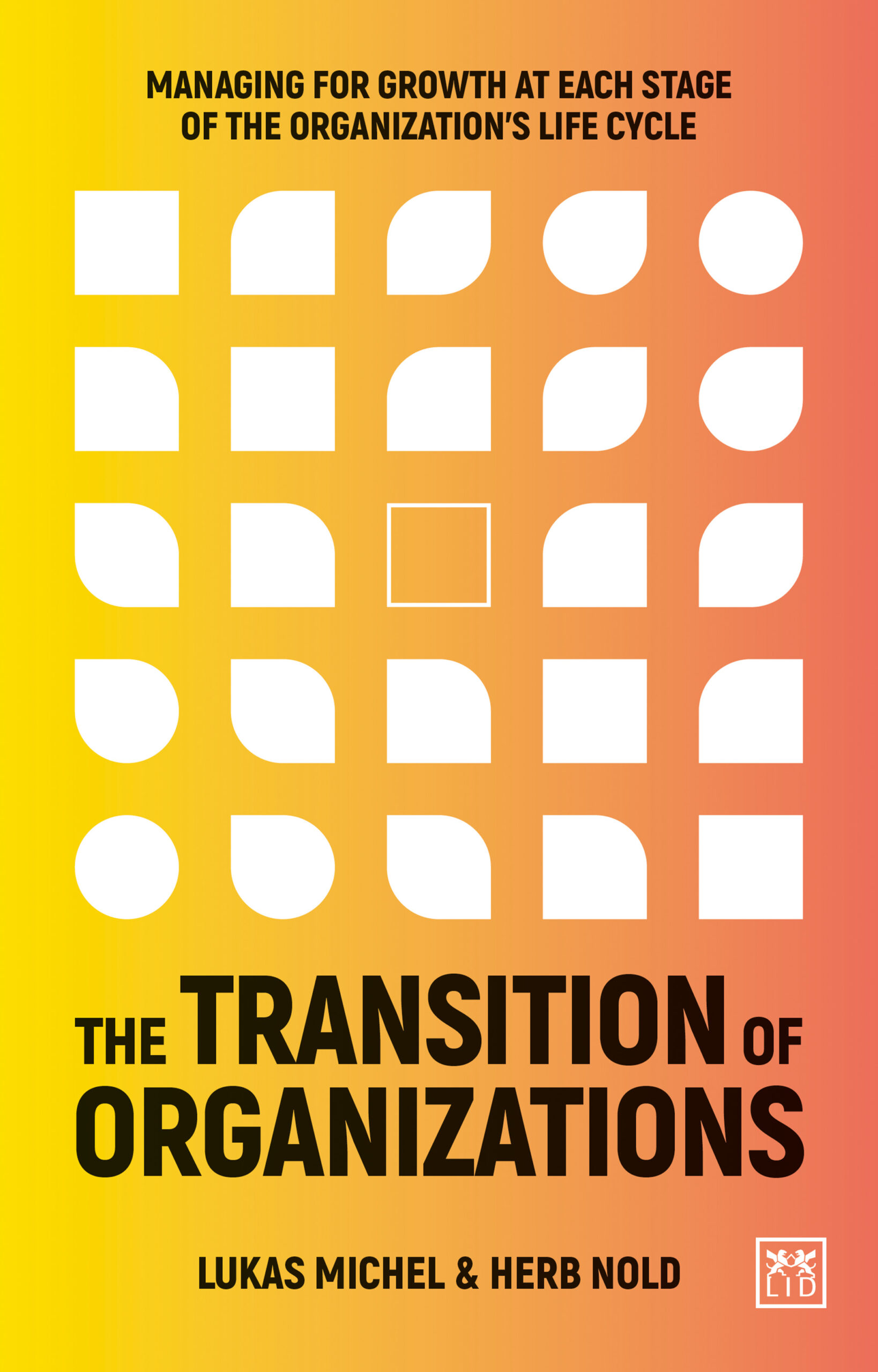|
Solving the Crisis of Leadership with Lukas Michel & Herb Nold
Solving the Crisis of Leadership

By Guest Contributors Lukas Michel & Herb Nold
Authors of The Transition of Organizations, Lukas Michel and Herb Nold, share how to overcome the crisis of leadership when your business grows.
The Transition of Organizations is the result of 20 years of work with clients around the globe and the related research that enabled us to conclude that there are patterns of deliberate strategies companies can follow to overcome their inherent structural crises.
Organizational growth follows five life cycle stages: creativity, direction, delegation, coordination, and collaboration. Every stage comes with specific evolutionary and revolutionary attributes, followed by a crisis or organizational challenge that must be overcome to advance to the next stage. We evaluate organizations by looking at their structure through the lens of viewing management as a competitive advantage. Mapping management patterns using the Leadership Scorecard tool allows us to identify the dominant management style for each life cycle stage.
More on the GROWTH LIFE CYCLES
The creativity stage. Entrepreneurial start-ups create innovative new products or create new markets. The founders are typically technical experts or highly creative, innovative people who see opportunities missed by others. Entrepreneurs typically have an informal management style that works just fine with a small group of highly motivated people who work closely together every day. As the organization grows and becomes more complex, however, this style creates the crisis of leadership. Putting people first is the strategy to overcome the crisis of leadership. That’s the clue to building direction capabilities.
The entrepreneurial organisation. The creativity life cycle stage consists of entrepreneurial organizations, including start-ups. The early stage of an organization tends to be informal, with the focus on creating new products and markets. Innovation and informality dominate the business and the management model.
Founders who run these new companies are typically visionaries who are technically or entrepreneurially oriented and see opportunities that are overlooked by others. They often have a distain for traditional, formal managerial activities. Their minds and energies are focused on making and selling the new product or service, with backroom or support activities viewed as more of a nuisance.
In the early phase of an organization, a powerful sense of purpose dominates the culture. Employees are motivated by their enthusiasm about the business idea and opportunities. The focus is on growth and early profitability as key measures. With an attractive new product or strategy, the business grows in size and complexity as new employees are hired to fill specific needs. Challenges are acted upon quickly and informally, with personal involvement by the founders. Everyone pulls together, sharing roles and responsibilities. People commonly wear multiple hats.
Crisis of leadership. As the organization develops, grows, and becomes more complex, it becomes too large to manage personally and informally. Formal systems and procedures are required as specialized functional departments are created to manage geographic, product or market expansion. Communication between locations and the newly created hierarchies becomes increasingly difficult when turf wars erupt as managers compete for resources and recognition. The entrepreneur and founder are no longer able to engage in all decisions and personally convey direction to all employees. As complexity and size increase, the leadership style of the typical entrepreneur is no longer sufficient to manage the organization. This situation leads to the crisis of leadership, which must be overcome to successfully continue along the growth path. Without effective controls and responsible leaders in key positions, inefficiencies accumulate and market opportunities are missed as unseen interferences creep into and infect the culture.
Solving the crisis of leadership. Moving from an entrepreneurial to a functional organization means putting people first in a predominantly rules-based mode of operations. This is all about enabling personal performance, which drives organizational performance. The inner game enables people to perform at their peak, such that they reach a state of flow, where time and space merge. When in the flow, work becomes easy, enjoyable, satisfying and highly motivating. People become highly engaged and want to do well, so they become responsible, productive, and innovative problem solvers.
People first.
Management modes describe four bundles of managerial principles and capabilities. Overlaying a range of traditional and people-centric management styles, operating in a range from stable to dynamic environments, produces four major quadrants representing the management modes. A people-first approach promotes the development of a work environment that enables employees to get work done and is a characteristic of better management.
To solve the crisis of leadership, enlightened management prioritizes the needs of people. Peter Drucker provided wise guidance for management: “There is only one valid purpose of a corporation: to create a customer.” Drucker saw that a company’s primary responsibility is to create value for customers. Since the first line of contact that customers have with a business is with employees, your people must become a major priority. With that in mind, the question then becomes where managers set their priorities. Managers are constantly beset by challenges and pressing issues, so they must prioritize their focus and energy. We suggest that the top priority should be developing skills and capabilities. Regardless of the management style or context, people drive performance. That is why people at the centre, are THE top priority.
The people-first priority offers the means to prevent the leadership crisis in the first place. When leaders recruit high-quality people and then develop self-responsibility throughout the organization, these conscientious employees can take care of clients without constant supervision. The result is that the founders can focus their energy on building an organizational foundation that will propel the company along the growth path.
The most visionary leaders work hard to establish an environment aligned with four priorities. Your primary responsibility as a leader is to develop the management systems that will support growth to the next level. However, releasing the energy, skills and capabilities of self-responsible people provides the fuel for growth, so they should be your primary focus.
- People are the centre of your attention.
- Your organization sets the context.
- Your people are the first line of contact with clients.
- Success is what appeals to owners.
Executives who can find the right balance of these proprieties, along with seeing to the interests of major stakeholders, will create public value. Applying better management practices creates value, not only for company stakeholders but for society in general.
Building direction capabilities. The inner game is the technique that enables people to perform at their peak and learn quickly. Application of inner-game principles helps create an environment that enables people to enter a state of flow. This drives performance and facilitates learning, both of which are needed to continue along the growth track.
Executives play the inner game to cope with the challenges of the outer game. They make decisions requiring understanding, thinking, acting, engaging, and adhering. They accept responsibility for decisions and are accountable for the results. Motivation for executives comes from a combination of individual responsibility and the opportunities and systems offered by the institution. The underlying features of the inner game are awareness, choice, trust and focus of attention.
Awareness, choice, and trust help people focus their attention on what counts. The result is flow, with peak learning, performance, and creativity. When employees operate in a state of flow, work becomes enjoyable and easy, as well as productive. Think of it as similar to when an athlete gets into the ‘zone’ and everything works. Flow shifts control over daily activities to the learner and redefines the role of the leader as that of coach instead of manager.
Solving the crisis of leadership relies on the executive’s ability to play the inner game. The principle of the inner game defines the most important concepts and techniques that promote flow, which helps individuals learn and perform at their peak. Flow results in the organization performing better, which drives continued growth.
Direction solves the leadership crisis. The transition from creativity to direction puts people first and calls for careful balance between control and creativity. The inner game and flow are the means to enable people to perform at their peak and solve the tension between people-first management and direction.
Entrepreneurial organizations have a design and management style that promotes innovation, creativity, and speed. Direct personal engagement between the founders and employees provides motivation and adequate management direction informally. Success and growth create the crisis of leadership, which must be resolved to continue successful growth. That growth comes from putting people first with inner game techniques that establish better directional capabilities.
What can you do?
- Take charge as a leader. Make people your first priority.
- Review your organization’s directive capabilities.
- Activate a rules-based management mode.
- Introduce or expand upon people-centric management techniques to help people play the inner game and achieve a state of flow.
Key words: creativity – the entrepreneurial organisation – crisis of leadership – people first (Solving the leadership crisis), building direction capabilities (the inner Game)
————————————————————————————————————————————————
Bibliography: Greiner, L. E. (1998). Evolution and Revolution as Organizations Grow. Harvard Business Review: Mai-June.
ABOUT THE AUTHOR

Suggested Reading
 The Transition of Organizations explores various common patterns of management styles and then offers transition strategies to help managers succeed in the digital economy. The authors guide leaders to prepare for these transitions by laying the foundations or infrastructure needed to prevent a crisis that inhibits further growth. They also provide leaders with a greater understanding of the growth framework, which will help leaders to manage better the development of their companies.
The Transition of Organizations explores various common patterns of management styles and then offers transition strategies to help managers succeed in the digital economy. The authors guide leaders to prepare for these transitions by laying the foundations or infrastructure needed to prevent a crisis that inhibits further growth. They also provide leaders with a greater understanding of the growth framework, which will help leaders to manage better the development of their companies.

